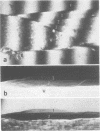Abstract
In cylindrical cells growing throughout their length, over-all transverse reinforcement of the wall by microfibrils is believed to be required for cell elongation. The multinet theory states that in such cells microfibrils are deposited at the inner surface of the wall with transverse orientation and are then passively reoriented toward the longitudinal direction by the predominant longitudinal strain (surface expension). In the present study young Nitella cells were physically forced to grow in highly abnormal patterns: in length only, in girth only, or with localized suppression of growth. Subsequent gradients of microfibrillar arrangement within the wall cross-section were measured with polarized light and interference microscopes. The novel wall structures produced were in all cases explainable by passive reorientation, i.e. by the multinet theory. The study also showed that orientation of synthesis remains insensitive to several of the physical manipulations that strongly influence the passive behavior of wall microfibrils. Only the localized complete suppression of surface growth led to the deposition of nontransverse cellulose. These results suggest that the presence of strain is needed for continued oriented synthesis, but that the directional aspect of strain is not an “instructional” agent continuously guiding the orientation of synthesis, once this orientation has been established.
Full text
PDF







Images in this article
Selected References
These references are in PubMed. This may not be the complete list of references from this article.
- Eisinger W. R., Burg S. P. Ethylene-induced Pea Internode Swelling: Its Relation to Ribonucleic Acid Metabolism, Wall Protein Synthesis, and Cell Wall Structure. Plant Physiol. 1972 Oct;50(4):510–517. doi: 10.1104/pp.50.4.510. [DOI] [PMC free article] [PubMed] [Google Scholar]
- GREEN P. B. Multinet growth in the cell wall of Nitella. J Biophys Biochem Cytol. 1960 Apr;7:289–296. doi: 10.1083/jcb.7.2.289. [DOI] [PMC free article] [PubMed] [Google Scholar]
- GREEN P. B. Structural characteristics of developing Nitella internodal cell walls. J Biophys Biochem Cytol. 1958 Sep 25;4(5):505–515. doi: 10.1083/jcb.4.5.505. [DOI] [PMC free article] [PubMed] [Google Scholar]
- Heath I. B. A unified hypothesis for the role of membrane bound enzyme complexes and microtubules in plant cell wall synthesis. J Theor Biol. 1974 Dec;48(2):445–449. doi: 10.1016/s0022-5193(74)80011-1. [DOI] [PubMed] [Google Scholar]
- Ray P. M. Radioautographic study of cell wall deposition in growing plant cells. J Cell Biol. 1967 Dec;35(3):659–674. doi: 10.1083/jcb.35.3.659. [DOI] [PMC free article] [PubMed] [Google Scholar]
- Roland J. C. The relationship between the plasmalemma and plant cell wall. Int Rev Cytol. 1973;36:45–92. doi: 10.1016/s0074-7696(08)60215-6. [DOI] [PubMed] [Google Scholar]
- Wilson K. The growth of plant cell walls. Int Rev Cytol. 1964;17:1–49. doi: 10.1016/s0074-7696(08)60404-0. [DOI] [PubMed] [Google Scholar]



